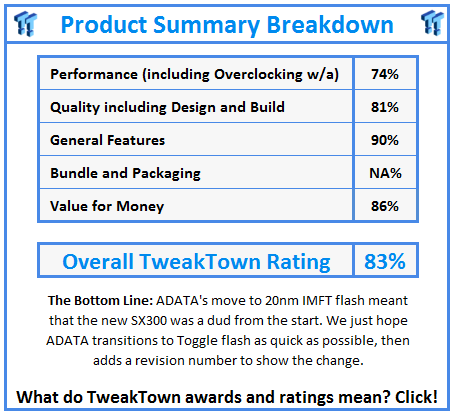Introduction
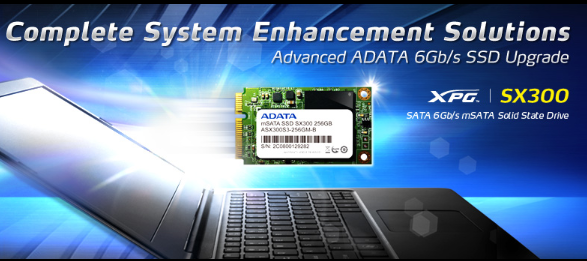
Even though hundreds of different products shipped with mSATA, the smallest SSD form factor for solid state drives, it didn't catch on as quickly as we expected. The high adaption issue doesn't have anything to do with supply or even a limited number of products with mSATA connectors. The low adaption can be blamed on education and advertising.
A large number of notebooks and ultrabooks in 2012 and 2013 shipped with an mSATA port under the keyboard, but most OEMs never advertised the feature. If your notebook was built to order from Dell, Lenovo, HP or one of the other big box OEMs, during the order process you were asked about installing a mSATA SSD. The SSDs offered were mostly for cache in a system that pairs a small SSD with a larger HDD. If you didn't choose to install the cache option, the OEMs would still send a system with the connector, they just wouldn't tell you about it.
Everyone I know wants more storage in their notebook, but most assume it's not possible. It's a notebook, there is only so much room. Wouldn't it be great to have a 256GB SSD and a 1TB HDD available on your mobile workspace? Chances are it IS possible, you just have to poke around to find the mSATA slot.
Today we're looking at the latest revision of the ADATA SX300, ADATA's flagship mSATA SSD. The SX300 uses the latest revision of the LSI SandForce SF-2281 controller, stepping B02. Let's take a look at the full specs.
Specifications, Pricing and Availability
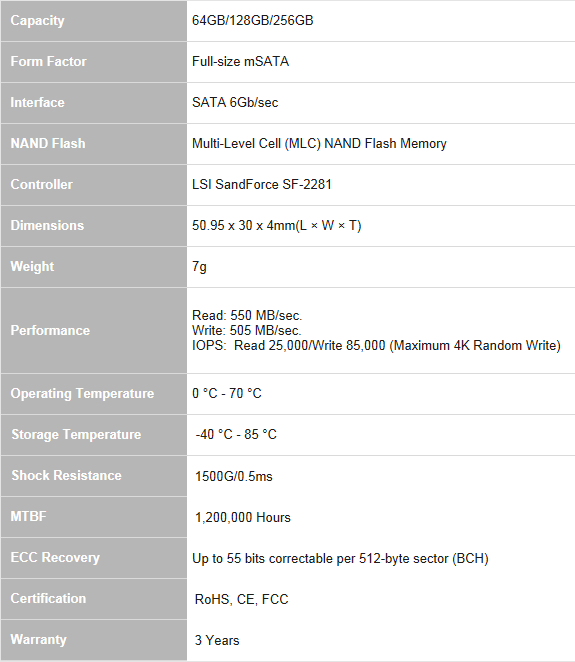
Available in three capacity sizes, the ADATA SX300 is a full size mSATA SSD and based on the latest LSI SandForce SF-2281 controller. ADATA chose to give users the full capacity of the NAND flash for storage, but since the 2281 will use any unoccupied space for background activities, performance doesn't suffer from the lack of reserved space under typical consumer workloads.
The latest version of the SX300 uses the new B02 stepping of the SF-2281 controller. B02 uses a few manufacturing tricks that SandForce picked up from LSI and B02 uses less power as a result. ADATA purchases Micron NAND flash and packages the die. The latest SX300 ships with 20nm ONFi flash running in synchronous mode. This mSATA drive should produce very impressive power consumption numbers - we'll find out later in the review.
Performance wise, ADATA claims 550 MB/s sequential read and 505 MB/s sequential write speed. The 4K read IOPS is quoted at 25K and the 4K write maximum is 85K.
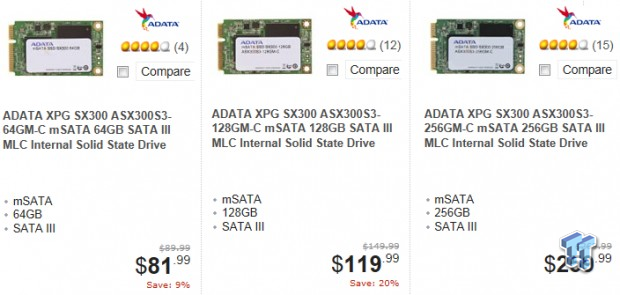
Newegg lists all three capacity sizes in stock and shipping. SX300 comes with a three year warranty. The package doesn't come with an accessory kit, but mSATA drives don't require anything fancy to start with.
The SX300 products don't come with an Acronis TrueImage key like the SX9xx series drives, something that surprised us after inspecting the package.
ADATA SX300 256GB mSATA SSD

ADATA put together an attractive package for the SX300 mSATA drive.
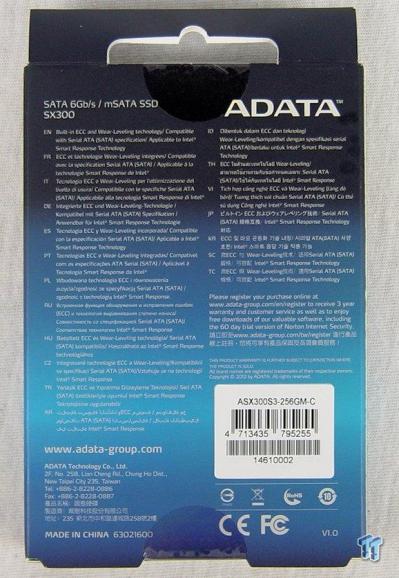
The back of the package lists a few details about the controller and the drive.
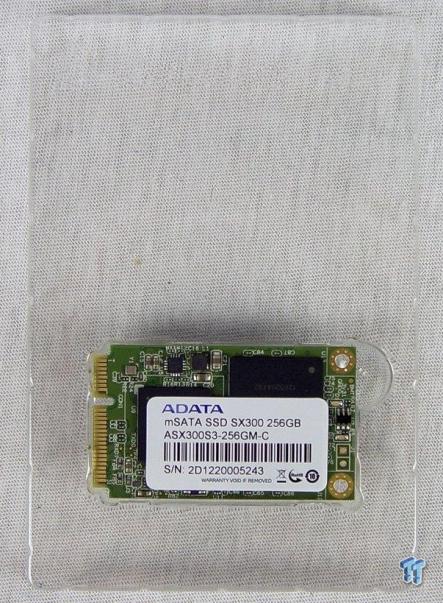
The drive is packaged well, so it shouldn't be harmed during shipping.
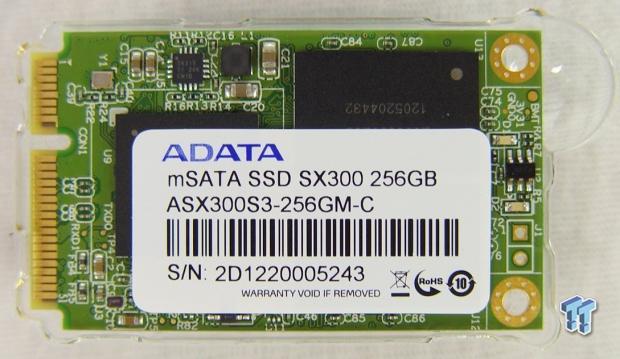
Here we get our first look at the drive. The label makes is difficult to see anything, so let's take it off.
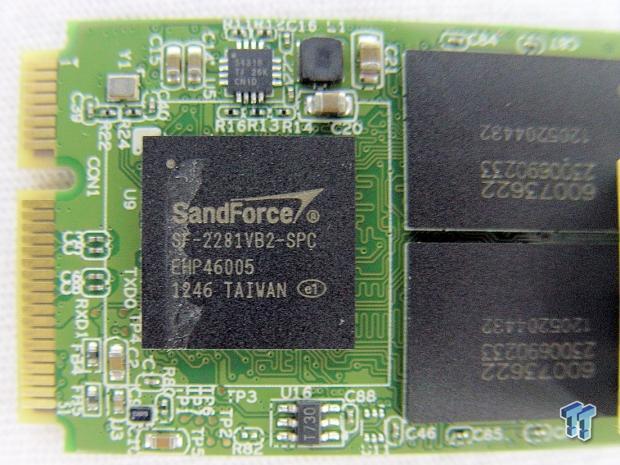
SF-2281VB2 refers to the new B02 spec SandForce controller.
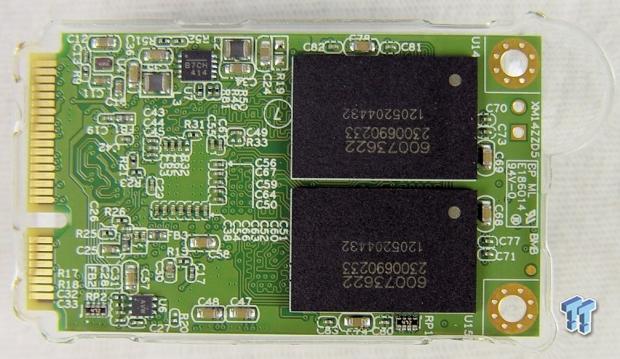
There are four flash packages on the SX300, two on each side.
Benchmarks - Test System Setup and ATTO Baseline Performance
Desktop Test System
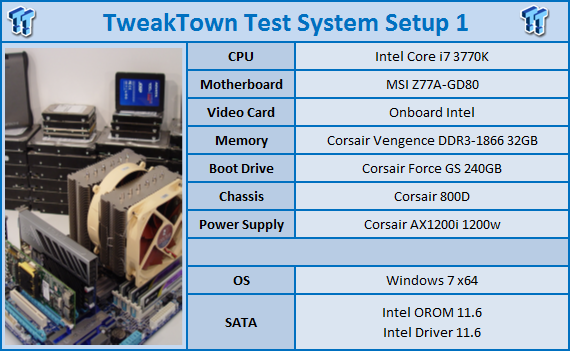
Lenovo W530 - Mobile Workstation
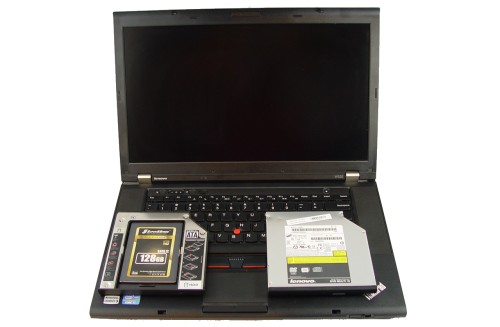
We use two systems for SSD testing. The desktop runs a majority of the tests and the Lenovo W530 runs the notebook power tests as well as the real-world file transfer benchmark.
ATTO Baseline Performance
Version and / or Patch Used: 2.34
ATTO is used by many disk manufacturers to determine the read and write speeds that will be presented to customers.
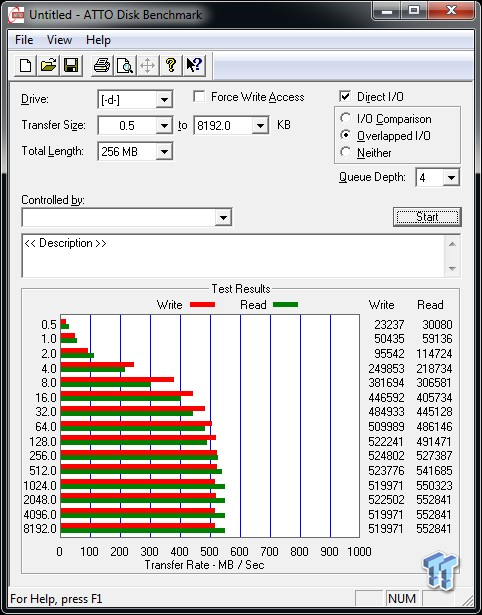
We managed to put ADATA's 505 MB/s write speed to shame. In our test we achieved 522 MB/s sequential write performance. Our maximum sequential write performance measured 553 MB/s, not bad for a 4-channel mSATA drive.
Benchmarks - Sequential Performance
HD Tune Pro
Version and / or Patch Used: 4.00
Developer Homepage: http://www.efdsoftware.com
Product Homepage: http://www.hdtune.com
HD Tune is a Hard Disk utility which has the following functions:
Benchmark: measures the performance
Info: shows detailed information
Health: checks the health status by using SMART
Error Scan: scans the surface for errors
Temperature display
HD Tune Pro gives us accurate read, write and access time results. It is now considered a must have application for storage device testing.
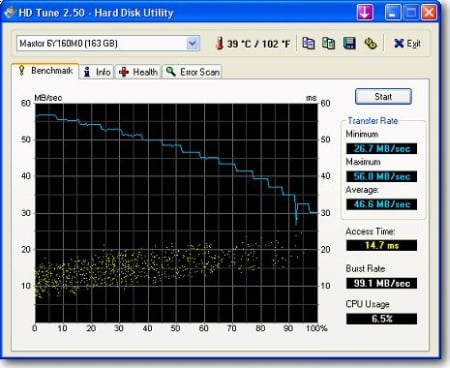
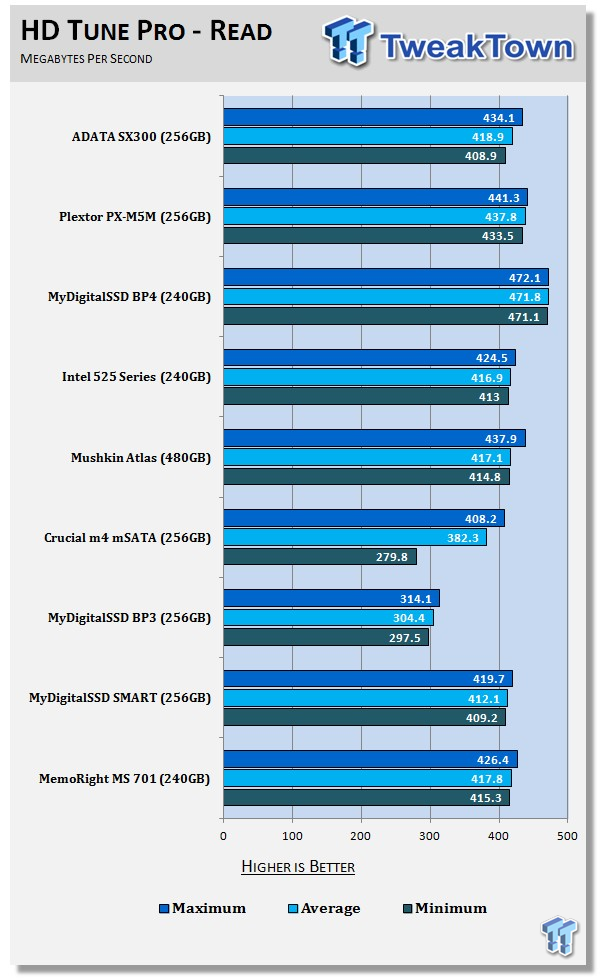
HD Tune Pro uses compressible data, we'll look at incompressible data later in the review. With 64KB blocks, the SX300 256GB does really well reading data across the span of the drive.
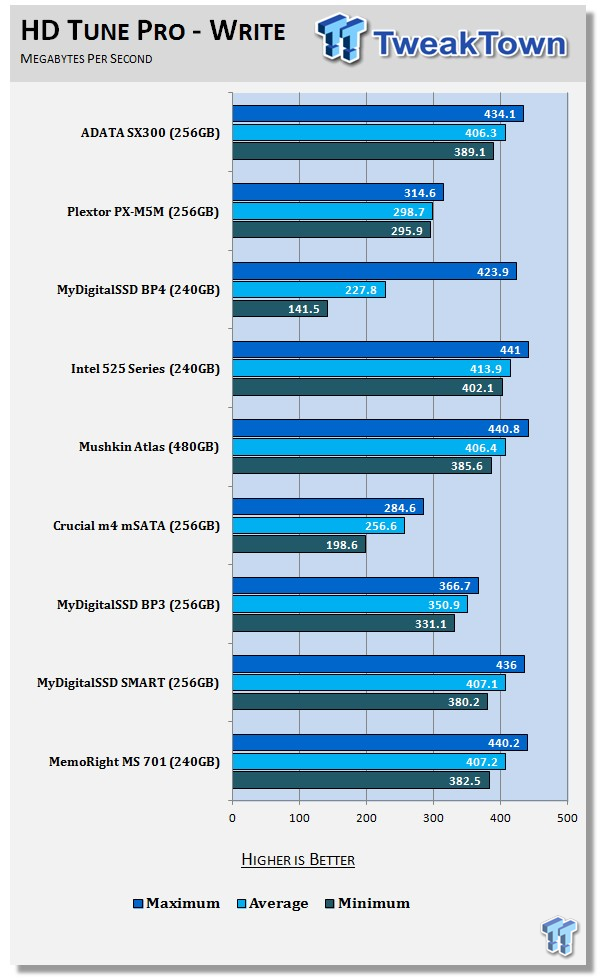
Writing compressible data going across the span of the drive the SX300 has no problem writing above 400MB/s.
HD Tach - Sequential Performance after Random Writes
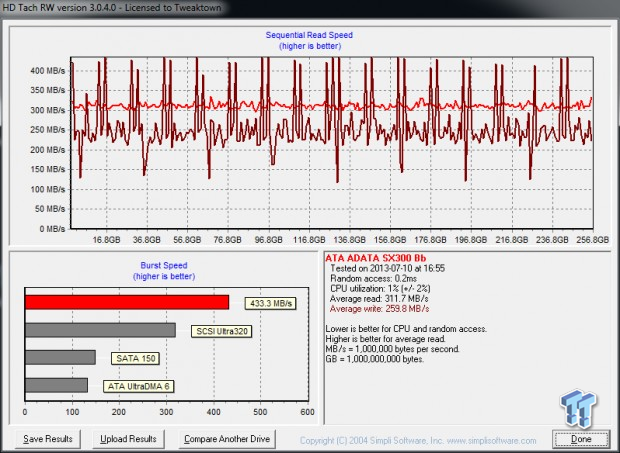
After a consumer appropriate amount of random writes to the drive, we ran HD Tack to see performance loss with sequential writes. The SX300 256GB drops down to just less than 150 MB/s in a few places.
Benchmarks - AIDA64 Random Access Time
AIDA64 Random Access Time
Version and / or Patch Used: 1.60
Developer Homepage: http://www.aida64.com
Product Homepage: http://www.aida64.com
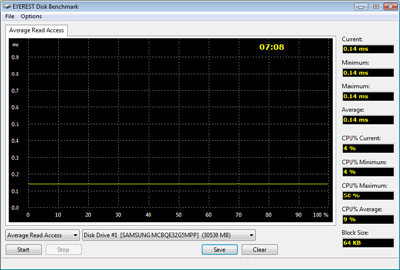
AIDA64 offers several different benchmarks for testing and optimizing your system or network. The Random Access test is one of very few if not only that will measure hard drives random access times in hundredths of milliseconds as oppose to tens of milliseconds.
Drives with only one or two tests displayed in the write test mean that they have failed the test and their Maximum and possibly their Average Scores were very high after the cache fills. This usually happens only with controllers manufactured by JMicron and Toshiba.
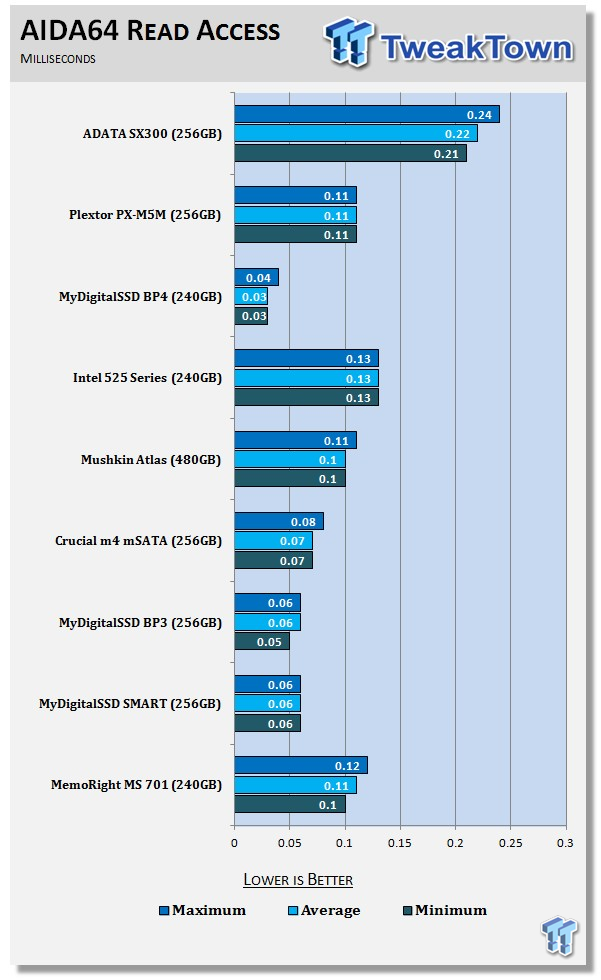
We've wrote about IMFT 20nm flash and the latency issues a handful of times before. The MyDigitalSSD SMART is a rebadged ADATA SX300 with 25nm IMFT flash. With that in mind, the new 20nm version nearly quadruples average read latency.
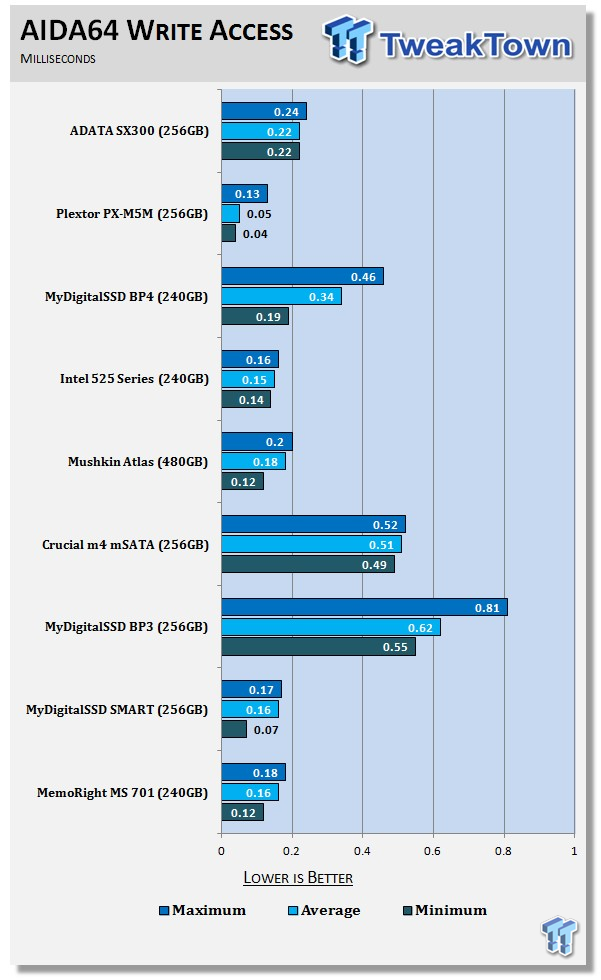
The write latency also increased with 20nm flash over 25nm.
Benchmarks - Anvil Storage Utilities
Anvil Storage Utilities
Version and / or Patch Used: RC6
So what is Anvil Storage Utilities? First of all, it's a storage benchmark for SSDs and HDDs where you can check and monitor your performance. The Standard Storage Benchmark performs a series of tests, you can run a full test or just the read or the write test or you can run a single test, i.e. 4K DQ16.
Anvil Storage Utilities is not officially available yet but we've been playing with the beta for several months now. The author, Anvil on several international forums has been updating the software steadily and is adding new features every couple of months.
The software is used several different ways and to show different aspects for each drive. We've chosen to use this software to show the performance of a drive with two different data sets. The first is with compressible data and the second data set is incompressible data. Several users have requested this data in our SSD reviews.
0-Fill Compressible Data
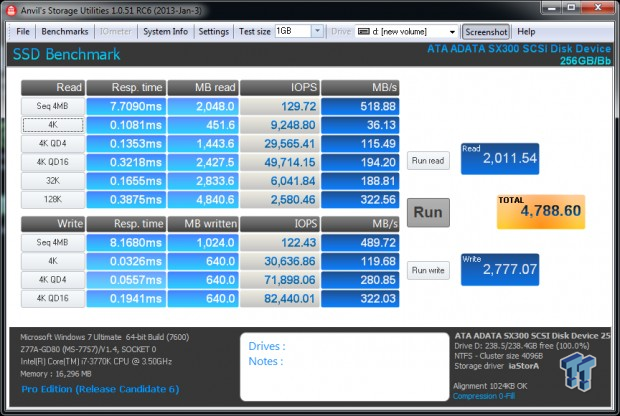
Incompressible Data
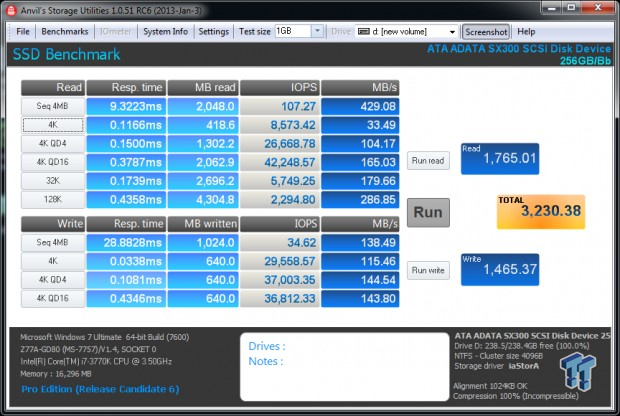
Being an LSI SandForce controller, there is a difference in performance between compressible and incompressible data. At the same time though, the write amplification is less than 1 with the SF-2281.
That means the SSD is actually writing less data to the flash than is actually being sent to the controller. As flash program erase cycles shrink with smaller die processes, DuraWrite becomes an even bigger advantage.
Read IOPS through Queue Depth Scale
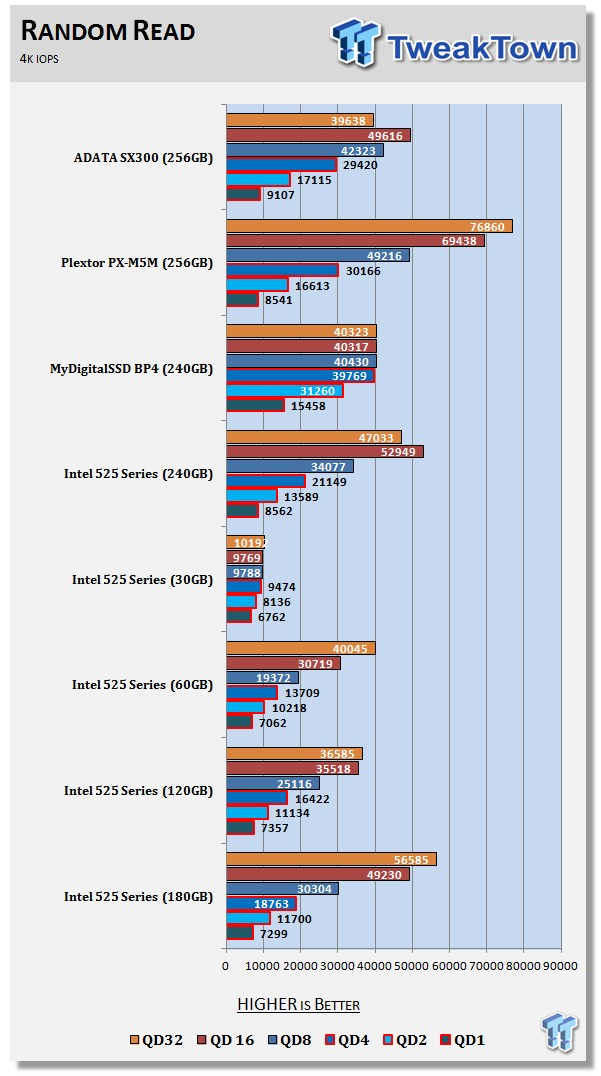
Companies are still marketing their high queue depth performance for consumer SSDs, but we like to highlight the low queue depth IOPS performance level, since most consumers will never get beyond QD4.
The SX300 256GB delivers 9,107 4KB read IOPS at QD1. This is the second best result on the chart, even higher than the Intel 525 240GB mSATA drive with 25nm flash.
Scaling Write IOPS through Queue Scale

At nearly 30K IOPS at QD1 when writing data, the SX300 256GB is very quick and will feel fast in your system. The LSI SandForce architecture has always felt very fast in real-world use.
Benchmarks - CrystalDiskMark
CrystalDiskMark
Version and / or Patch Used: 3.0 Technical Preview
Developer Homepage: http://crystalmark.info
Product Homepage: http://crystalmark.info/software/CrystalDiskMark/index-e.html
Download here: http://crystaldew.info/category/software/crystaldiskmark
CrystalDiskMark is a disk benchmark software that allows us to benchmark 4K and 4K queue depths with accuracy.
Key Features:-
* Sequential reads/writes
* Random 4KB/512KB reads/writes
* Text copy
* Change dialog design
* internationalization (i18n)
Note: Crystal Disk Mark 3.0 Technical Preview was used for these tests since it offers the ability to measure native command queuing at 4 and 32.
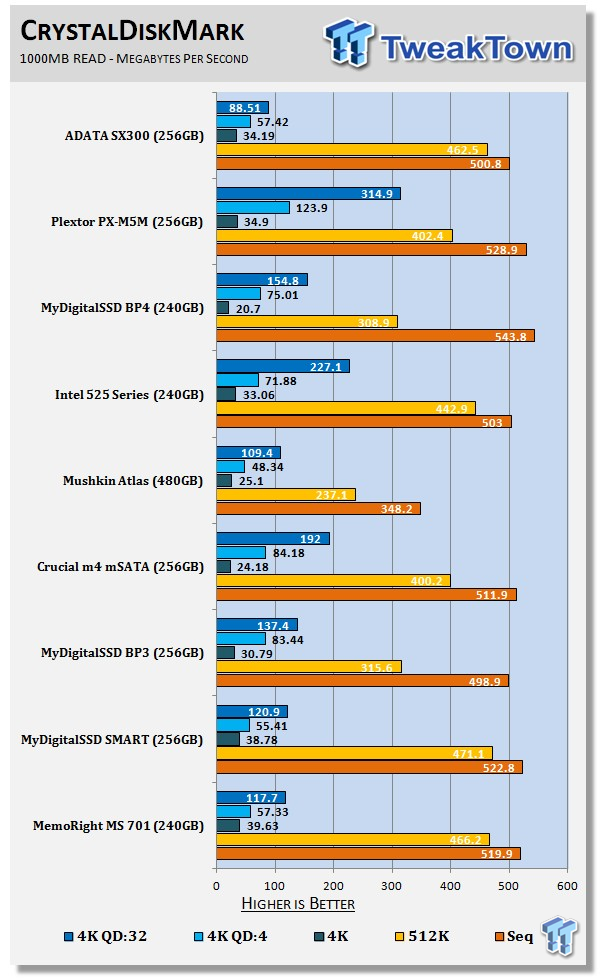
Here we get our first look at incompressible data on the SX300. The sequential reads stay high and the 4K reads are approaching 35 MB/s. The new SX300 with 20nm flash doesn't scale well when commands are stacked.
Our review sample shipped with firmware 5.0.Be, the same that was on our ADATA M.2 sample back at Computex. We're still coming to terms with the new firmware and the new 20nm flash. At this point we don't know if the firmware or the flash is slowing the 4K reads when we ratchet the drive up with more commands.
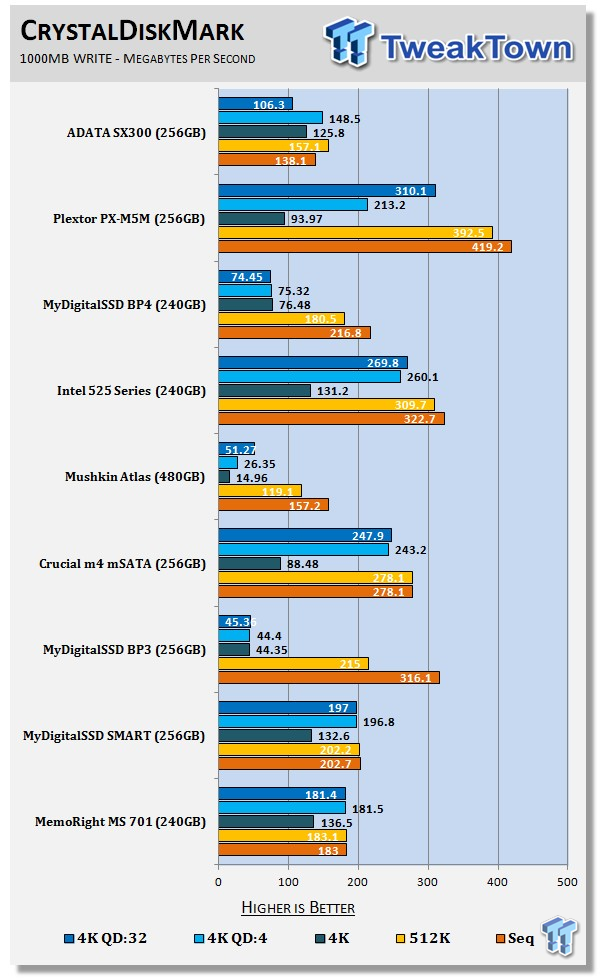
One thing is for sure, the combination of 20nm and 5.0.Be firmware doesn't do incompressible writes any favors. I had to double check to make sure I wasn't testing the SX300 128GB that I also have in my office.
With the 128GB class SandForce drives, we talk about a brick wall in this test. The 256GB drives have never had an issue with a sudden stop in performance, the SX300 doesn't really do it either, but the result is even worse. We measured a very good 4K QD1 write score, but the sequential writes are horrid with incompressible data.
Benchmarks - PCMark Vantage Hard Disk Tests
PCMark Vantage - Hard Disk Tests
Version and / or Patch Used: 1.0.0
Developer Homepage: http://www.futuremark.com
Product Homepage: http://www.futuremark.com/products/pcmarkvantage

PCMark Vantage is the first objective hardware performance benchmark for PCs running 32 and 64 bit versions of Microsoft Windows Vista. PCMark Vantage is perfectly suited for benchmarking any type of Microsoft Windows Vista PC from multimedia home entertainment systems and laptops to dedicated workstations and high-end gaming rigs. Regardless of whether the benchmarker is an artist or an IT Professional, PCMark Vantage shows the user where their system soars or falls flat, and how to get the most performance possible out of their hardware. PCMark Vantage is easy enough for even the most casual enthusiast to use yet supports in-depth, professional industry grade testing.
FutureMark has developed a good set of hard disk tests for their PCMark Vantage Suite. Windows users can count on Vantage to show them how a drive will perform in normal day to day usage scenarios. For most users these are the tests that matter since many of the old hat ways to measure performance have become ineffective to measure true Windows performance.
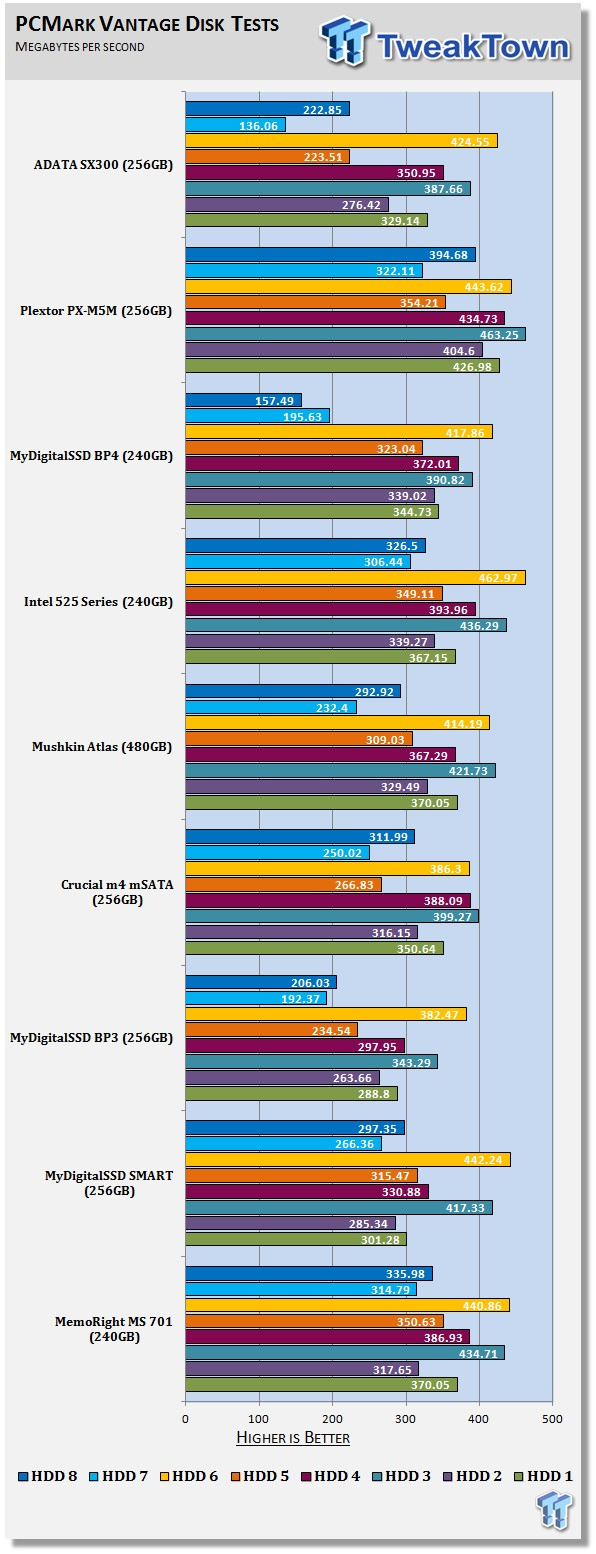
HDD1 - Windows Defender
HDD2 - Gaming
HDD3 - Windows Photo Gallery
HDD4 - Vista Startup
HDD5 - Windows Movie Maker
HDD6 - Windows Media Center
HDD7 - Windows Media Player
HDD8 - Application Loading
The SX300 256GB does well in the real-world, daily use tests, but there are some places where you can see the limited sequential writes slowing things down.
Most consumer computing is read intensive with only small writes going to the drive and because of that the SX300 is still a fast mSATA drive for OS and program use.
Benchmarks - PCMark Vantage - Drives with Data Testing
For a complete breakdown on the Drives with Data Testing please read this article. You will be able to perform this test at home with the files provided in the article - full instructions are included.
- Brief Methodology
SSDs perform differently when used for a period of time and when data is already present on the drive. The purpose of the Drives with Data testing is to show how a drive performs in these 'dirty' states. SSDs also need time to recover, either with TRIM or onboard garbage collection methods.
Drives with Data Testing - 25%, 50%, 75% Full States and Dirty / Empty Test
Files needed for 60 (64GB), 120 (128GB), 240 (256GB)
60GB Fill - 15GB, 30GB, 45GB
120GB Fill - 30GB, 60GB, 90GB
240GB Fill - 60GB, 120GB, 160GB
Empty but Dirty - a test run just after the fill tests and shows if a drive needs time to recover or if performance is instantly restored.

The LSI SandForce controller with its data compression has always performed well in this test since the flash doesn't take the full brunt of the data written to the controller. The 20nm flash only allowed the SX300 to get up to the 60K Mark range, so this drive is already at a disadvantage.
With 50% of the capacity of the drive filled with data, which in this case means sent to the drive and not actually written to the flash, the SX300 doesn't do as well as the Intel 525 240GB.
Benchmarks - BootRacer
BootRacer - System Boot Time
Version and / or Patch Used: 4.0
Developer Homepage: Greatis
Product Homepage: BootRacer
Download here: http://www.greatis.com/bootracer/download.htm
Note: In this test we use the Lenovo W530 Mobile Workstation loaded with an operating system and several program files. The data on the drive at the time of the test is 45GB. The second test, 50GB Free, was ran with the drives filled with block data until only 50GB of free capacity remained.
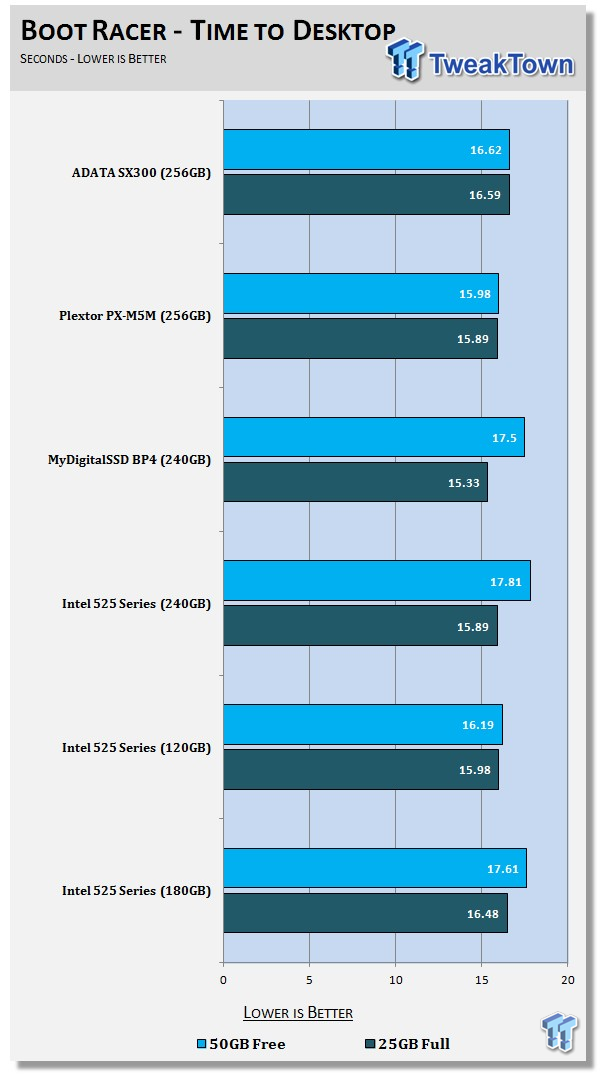
Rebooting Windows7 Ultimate takes between 16 and 17 seconds. The result is quite a bit less than a spinner, but some of the other drives shave a second off the SX300's result.
Benchmarks - DiskBench
DiskBench - Directory Copy
Version and / or Patch Used: 2.6.2.0
Developer Homepage: Nodesoft
Product Homepage: DiskBench
Download here: http://www.nodesoft.com/diskbench/download
Note: In this test we use the Lenovo W530 Mobile Workstation and a SuperSSpeed S301 SLC 128GB SSD to move a 15GB block of data to and from the target drive. This is part of our real-world test regiment. Roughly 45GB of data resides on the target drive before the '15GB Block' is transfer. The 15GB Block is the same data we built for the Data on Disk Testing and is a mix of compressible and incompressible data.
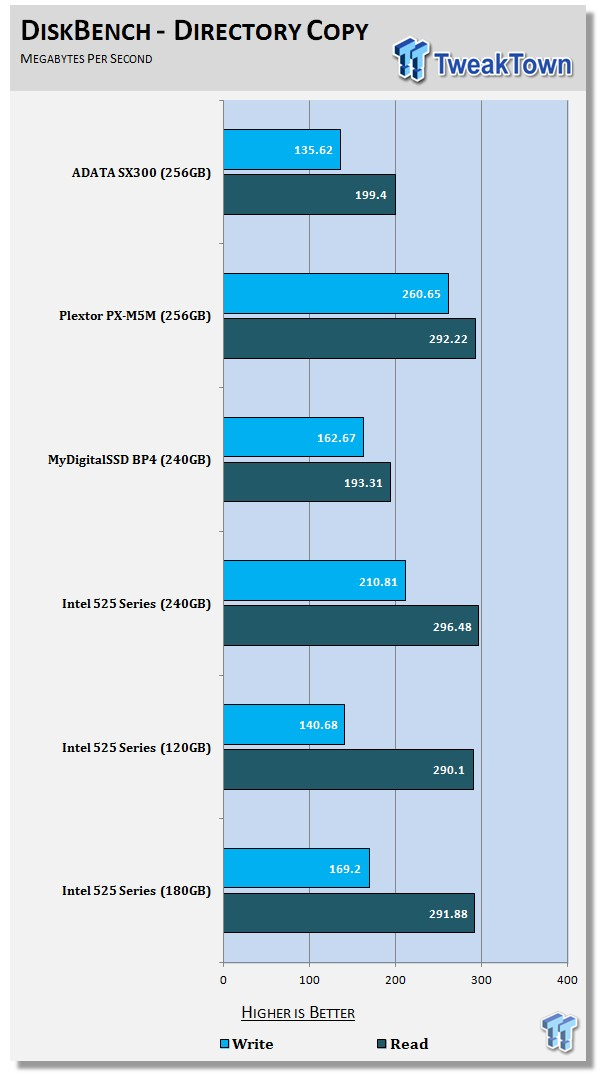
This data transfer test uses both compressible and incompressible data with both large and small files sizes. The 20nm flash obviously came from hell, spawned from the devil himself.
When a 128GB class drive with the same controller manages to outperform a 256GB drive, something is wrong and that something wasn't ADATA or SandForce's fault.
Benchmarks - Power Testing
Bapco MobileMark 2012 1.5
Version and / or Patch Used: 2012 1.5
Developer Homepage: http://www.bapco.com
Test Homepage: http://www.bapco.com
MobileMark 2012 1.5 is an application-based benchmark that reflects usage patterns of business users in the areas of office productivity, media creation and media consumption. Unlike benchmarks that only measure battery life, MobileMark 2012 measures battery life and performance simultaneously, showing how well a system design addresses the inherent tradeoffs between performance and power management.
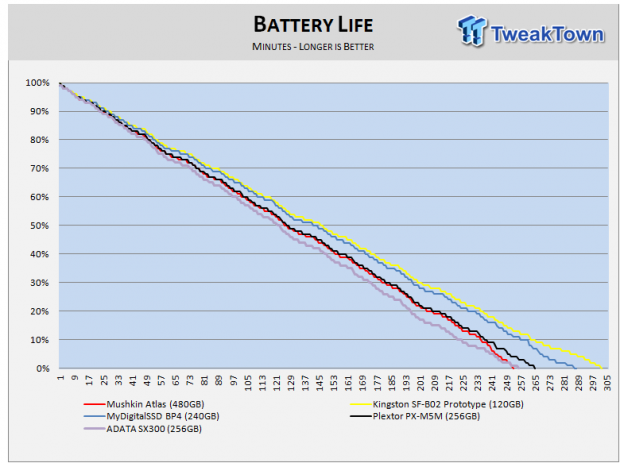
The battery life test many actually be a result of ADATA's design. If you read our Samsung 840 EVO review then you know we damaged our battery in the Lenovo W530. The ADATA SX300 is the drive we had testing when I had to run to the airport for a weeklong trip to Korea. The battery was fine during the test, but we left it drained for a week without a charge. The test completes when the battery dies and the system has an ungraceful shutdown. I wanted to mention this for the readers who look at every SSD review we publish. The battery was fine during this test.
That said, the battery was fine, but the SX300 wasn't. The LSI SandForce B02 controller normally pulls less power than the normal SF-2281 controller. The 20nm flash should also use less power than the older 25nm, we proved that theory with the Intel 335 240GB review.
Other components, like the VRMs (voltage regulators) and other surface mount components that we normally overlook take power as well. If a company uses components that are not as efficient as others, it shows up in this test.
PCMark Vantage HDD Tests - Power Draw
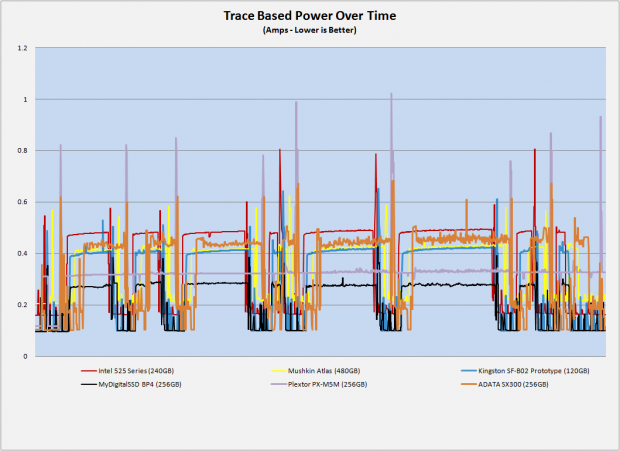
Here we look at power consumption under a microscope. The ADATA SX300 has a low idle, but pulls a lot of data when reading and writing. On the chart you can also see where tests start and stop.
A slower SSD will start later in the tests (there are 8 total) on the chart. If a test takes longer, then the drive is in use longer. That means it consumes more power to finish a task. We call this "time in use busy time", and busy time means power consumption time.
Final Thoughts
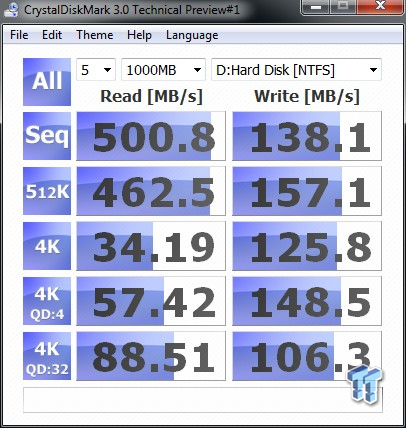
I haven't published this little tidbit of information before because I was never able to get a second confirmation, so just consider this way out there on the rumor mill. I was told that in a warehouse in China, IMFT 20nm flash is stacked up like 10 feet high because it's not SSD grade. We've published a few stories about the new 20nm flash and called it a shortage, which we hear all of the time from manufacturers, but the shortage might just be because most of it is crap (a technical term). We also keep hearing that the yields are awful, and if the Chinese warehouse story is in fact true, then we know where the flash is piling up. On the bright side, maybe we'll have really cheap large capacity thumb drives in time for Christmas!
Ever since we started testing IMFT 20nm flash, around 13 months ago, we weren't impressed. The results shown here are actually worse than our initial tests with early 20nm flash. For as long as I can remember, ADATA has used IMFT flash, but a review published by Hot Hardware of a new revision SX900 had SanDisk Toggle 2 flash. Our review sample arrived before the Hot Hardware review went online. Hopefully ADATA moved all of the SX products over to Toshiba / SanDisk flash. Our SX300 sample, the one we tested today, wasn't one of the lucky ones.
With Intel 525 Series drives still available with 25nm flash, but discontinued, it's difficult to tell you to buy the SX300 in this form. It's actually really easy to tell you to pass on the 20nm version. If you are lucky enough to find a SX300 with 25nm flash or better yet, Toshiba / SanDisk Toggle, you have my blessing to buy it, because it's a superior build.
The sad thing is ADATA keeps changing their builds without any notice or indication as to what an e-tailer is offering. Years ago, anytime a controller or flash changed, manufacturers would make a new model number. That doesn't happen as much anymore and it's a pain in the ass when shopping for a quality SSD. Come on manufacturers - slap a revision number on these things so people know what they are buying!
I do want to thank ADATA for sending the SX300 256GB without hesitation. ADATA sent us this drive knowing that we are one of the few review websites that spend the time to dissect the components and performance before telling our readers to buy a product or to pass on it. There are companies out there shipping products with 20nm flash and trying to keep the products away from reviewers.

